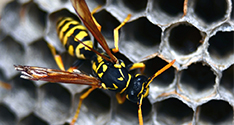
Most of the commonly encountered stinging pests, other than the scorpion, belong to the insect order called Hymenoptera, which contains ants, bees and wasps. In forests and fields, these insects are highly beneficial – bees pollinate flowers and wasps are predators of difficult to manage insects. However, when these pests live near or in the home, they pose a threat to people and pets, and often need to be controlled.
More people die each year in the U.S. from insect stings than from poisonous snake bites. Many people are allergic to insect stings. Some people are so allergic that they could die from one sting if medical attention were not immediately provided. Severely allergic people often must carry an insect sting kit to give themselves immediate medical attention in case of a sting.
Controlling Stinging Pests
Contact Terminix® for pest management. When treating the nests of stinging pests like social bees and wasps, Terminix professionals wear protective clothing to guard against harmful stings.
Special Considerations
A consultation with a beekeeper may be appropriate if you suspect you have honey bees. These are valuable insects and should be conserved whenever possible. If the colony cannot be removed, it may be treated.
If the honey bee colony is located within your walls, they will need to be opened up so the honeycombs can be removed. If this is not done, the honey will seep through, stain the walls and create a strong odor in the house. Also, the honey will attract other types of pests to your home. Honey from treated colonies is NOT fit to eat!



